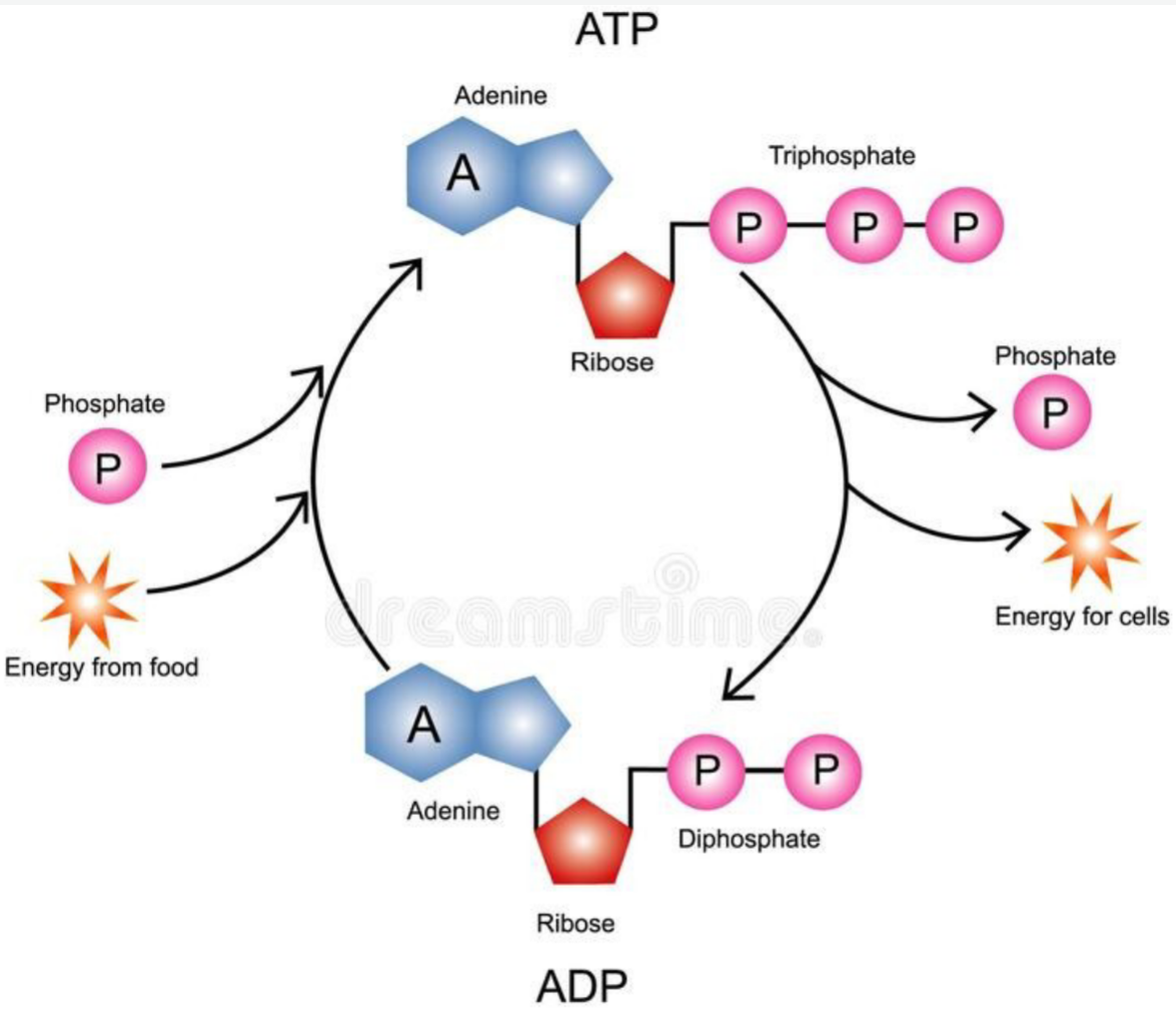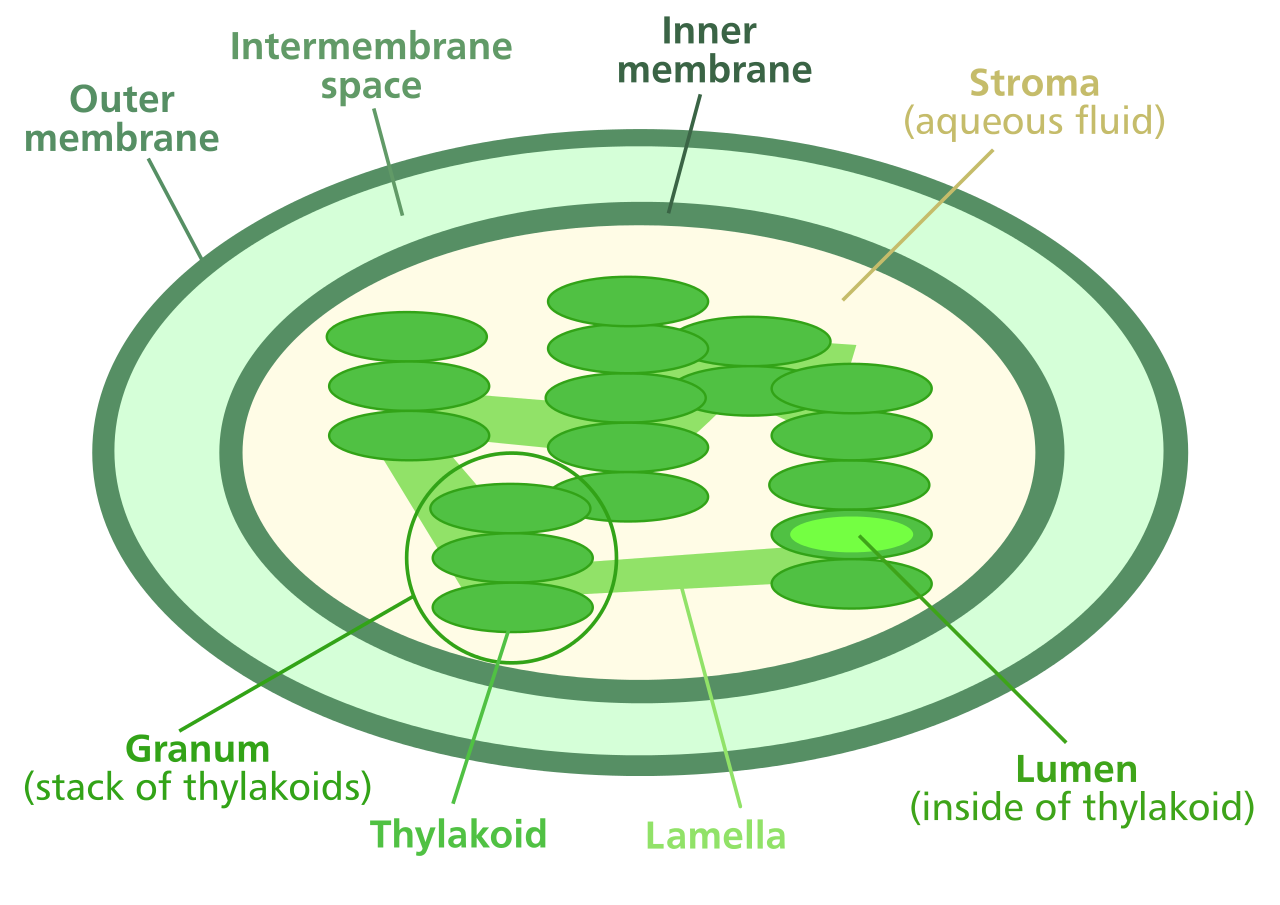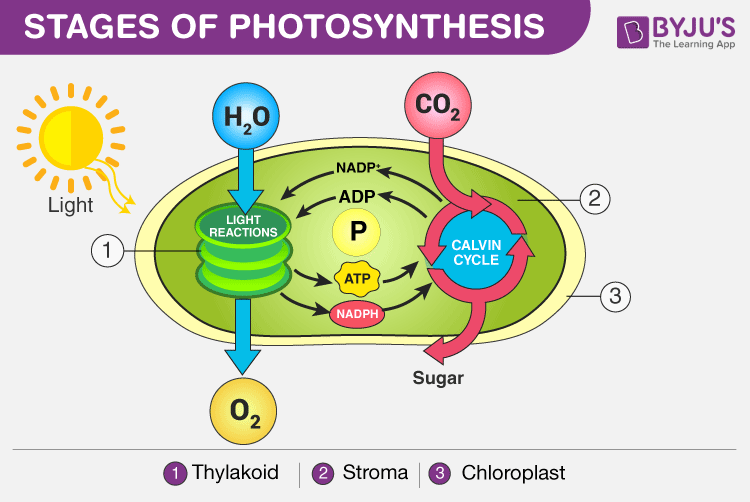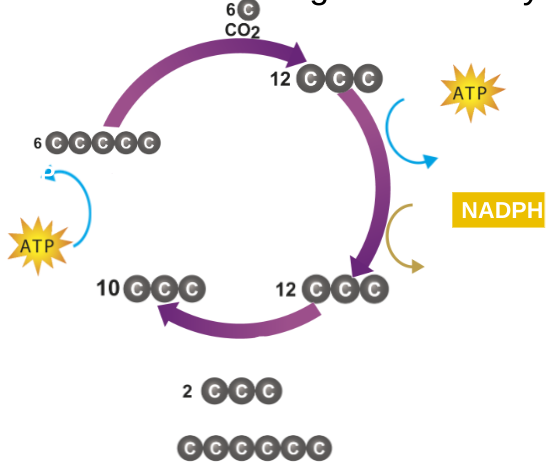
Bio Chapter 8 - Photosynthesis
Lesson 8.1 - Energy & Life
Energy
Energy comes from food
All living things need energy to live
Food gets its energy from the sun
Some organisms use light to create energy
Organims that make their own food are called autotrophs
Organims that consume their energy are called heterothrophs
Chemical Energy + ATP
Energy can come from light, heat, and electricity
Can be stored in chemical compounds
Cells store and use ATP
ATP is made of:
Adenine
Ribose (5-sugar molecule)
3 phosphate groups
The phosphate groups are the key to ATP use and recycling
Storing Energy
ADP has 2 phosphate groups instead of 3
A cell can store a small amount of energy by adding one phosphate
Releasing Energy
Energy is released by breaking one phosphate bond
This bond must be between the second and third bond
Cellular Activites
Can be used for:
Active transport across cell membranes
Protein synthesis
Muscle contraction
Most cells don’t store a lot of ATP because it is not able to store large amounts of energy
Cells can regulate ATP from ADP as needed by using the energy in foods like glucose

Lesson 8.2 - Photosynthesis Overview
The Photosynthsis Equation
Process in which green plants use the energy of sunlight to convert water and carbon dioxide into high-energy carbs and oxygen
6CO2 + 6H2O → C6H12O6 + 6O2
Lights + Pigments
Photosynthesis also requires light and chlorophyll
Plants absorb the sun’s energy with pigments
Pigments are light-absobing
The main pigment in plants is chlorophyll
Two main types of chlorophyll:
chlorophyll a
chlorophyll b
Chlorophyll absorbs light very well in the blue-violet and red regions
This means that these colors are not visible to the naked eye on trees
Chlorophyll does not absorb light very well in the green and yellow regions
This means that these colors are visible to the naked eye on trees
Light is a form of energy, so when light is absorbed, so is energy
When light is absorbed, much of the energy is moved directly to the electrons in the molecule, raising the energy levels of these electrons
These electrons are what make photosynthesis work
Electrons are excited by light
Factors Affecting Photosynthesis
Factors Affecting The Rate of Photosynthesis:
Water
Carbon D
Temp
Intensity of Light
Ur Mom and Wooster The Rooster
Enzymes do the physical work of making photosynthesis occur
More reactants, more enzymes, more work done
You need more than just light for photosynthesis to be successful
Lesson 8.3 - Reactions of Photosynthesis
Inside a Chloroplast
Photosynthsis occurs inside chloroplasts
Chloroplasts contain thylakoids
These are saclike photosynthetic membranes
Thylakoids are arranged in stacks known as grana
A singular stack is called a granum
Proteins in the thylakoid membrane organize chlorophyll and other pigments into clusters called photosystems
These are light-collecting units of the chloroplast

Steps to Photosynthesis
There are 2 steps to Photosynthesis:
Light-dependent reactions
These take place in the thylakoid membranes
Light-independent reaction (also known as the Calvin Cycle)
These take place in the stroma, which is the cytoplasm part of the chloroplast
Electron Carriers
When electrons in chlorophyll absorb sunlight, the electrons gain a great deal of energy
Cells use electron carriers to transport these high-energy electrons to other molecules
One carrier is called NADP+
Transports 2 high-energy electrons along with a hydrogen ion (the parent)
Convert NADP+ into NADPH
NADPH can store some of the energy from sunlight in chemical form
The energy stored in NADPH can be used to build a variety of molecules including glucose (sugars) and carbs

Light-Dependent Reactions
Require light
Produce oxygen gas and convert ADP and NADP+ into the energy carries ATP and NADPH
Inside A Thylakoid Processes:
Photosynthesis begins when pigments in photosystem II absorb light, increasing their energy level
These high-energy electrons are passed on to the electron transport chain
Enzymes on the thylakoid membrane break water molecules into:
hydrogen ions
oxygen atoms
energized electrons
The energized electrons from water replace the high-energy electrons that chlorophyll lost to the electron transport chain
As plants remove electrons from water, oxygen is left behind and is released into the air
The hydrogen ions left behind when water is broken apart are released inside the thylakoid membrane
Energy from the electrons moving down the electron transport chain (ETC) is used to transport H+ ions from the stroma into the inner thylakoid space
High-energy electrons move through the electron transport chain from photosystem II to photosystem I
Pigments in photosystem I use energy from light to re-energize the electrons
NADP+ then picks up these high-energy electrons, along with H+ ions, and becomes NADPH
As electrons are passed from chlorophyll to NADP+, more H+ ions are pumped across the membrane causing a concentration gradient
The inside of the membrane has a high concentration of positively charged hydrogen ions, which makes the outside of the membrane negatively charged
The difference in charges across the membrane provides the energy to make ATP
H+ ions cannot cross the membrane directly, so the cell membrane contains a protein called ATP synthase that allows H+ ions to pass through it
As it rotates, ATP synthase binds ADP and a phosphate group together to produce ATP
Because of this system, light-dependent electron transport produces not only high-energy electrons but ATP as well
Summary of Light-Dependent Reaction
Light-dependent reaction use water, ADP, and NADP+
Produce: Oxygen, ATP, and NADPH
These provide the energy to build sugars from low-energy compounds
Calvin Cycle
ATP and NADPH have a lot of chemical energy but are unstable to store energy for longer than a moment
During this cycle, plants use the ATP and NADPH to build high-energy compounds that can be stored for a long time
Uses ATP and NADPH from the light-dependent reactions to produce high-energy sugars
These reactions are called light-independent

Summary:
Two sets of photosynthetic reactions work together
Light-dependent reactions trap sunlight in chemical form
They use this energy to create stable, high-energy sugars from carbon and water
Bio Chapter 8 - Photosynthesis
Lesson 8.1 - Energy & Life
Energy
Energy comes from food
All living things need energy to live
Food gets its energy from the sun
Some organisms use light to create energy
Organims that make their own food are called autotrophs
Organims that consume their energy are called heterothrophs
Chemical Energy + ATP
Energy can come from light, heat, and electricity
Can be stored in chemical compounds
Cells store and use ATP
ATP is made of:
Adenine
Ribose (5-sugar molecule)
3 phosphate groups
The phosphate groups are the key to ATP use and recycling
Storing Energy
ADP has 2 phosphate groups instead of 3
A cell can store a small amount of energy by adding one phosphate
Releasing Energy
Energy is released by breaking one phosphate bond
This bond must be between the second and third bond
Cellular Activites
Can be used for:
Active transport across cell membranes
Protein synthesis
Muscle contraction
Most cells don’t store a lot of ATP because it is not able to store large amounts of energy
Cells can regulate ATP from ADP as needed by using the energy in foods like glucose

Lesson 8.2 - Photosynthesis Overview
The Photosynthsis Equation
Process in which green plants use the energy of sunlight to convert water and carbon dioxide into high-energy carbs and oxygen
6CO2 + 6H2O → C6H12O6 + 6O2
Lights + Pigments
Photosynthesis also requires light and chlorophyll
Plants absorb the sun’s energy with pigments
Pigments are light-absobing
The main pigment in plants is chlorophyll
Two main types of chlorophyll:
chlorophyll a
chlorophyll b
Chlorophyll absorbs light very well in the blue-violet and red regions
This means that these colors are not visible to the naked eye on trees
Chlorophyll does not absorb light very well in the green and yellow regions
This means that these colors are visible to the naked eye on trees
Light is a form of energy, so when light is absorbed, so is energy
When light is absorbed, much of the energy is moved directly to the electrons in the molecule, raising the energy levels of these electrons
These electrons are what make photosynthesis work
Electrons are excited by light
Factors Affecting Photosynthesis
Factors Affecting The Rate of Photosynthesis:
Water
Carbon D
Temp
Intensity of Light
Ur Mom and Wooster The Rooster
Enzymes do the physical work of making photosynthesis occur
More reactants, more enzymes, more work done
You need more than just light for photosynthesis to be successful
Lesson 8.3 - Reactions of Photosynthesis
Inside a Chloroplast
Photosynthsis occurs inside chloroplasts
Chloroplasts contain thylakoids
These are saclike photosynthetic membranes
Thylakoids are arranged in stacks known as grana
A singular stack is called a granum
Proteins in the thylakoid membrane organize chlorophyll and other pigments into clusters called photosystems
These are light-collecting units of the chloroplast

Steps to Photosynthesis
There are 2 steps to Photosynthesis:
Light-dependent reactions
These take place in the thylakoid membranes
Light-independent reaction (also known as the Calvin Cycle)
These take place in the stroma, which is the cytoplasm part of the chloroplast
Electron Carriers
When electrons in chlorophyll absorb sunlight, the electrons gain a great deal of energy
Cells use electron carriers to transport these high-energy electrons to other molecules
One carrier is called NADP+
Transports 2 high-energy electrons along with a hydrogen ion (the parent)
Convert NADP+ into NADPH
NADPH can store some of the energy from sunlight in chemical form
The energy stored in NADPH can be used to build a variety of molecules including glucose (sugars) and carbs

Light-Dependent Reactions
Require light
Produce oxygen gas and convert ADP and NADP+ into the energy carries ATP and NADPH
Inside A Thylakoid Processes:
Photosynthesis begins when pigments in photosystem II absorb light, increasing their energy level
These high-energy electrons are passed on to the electron transport chain
Enzymes on the thylakoid membrane break water molecules into:
hydrogen ions
oxygen atoms
energized electrons
The energized electrons from water replace the high-energy electrons that chlorophyll lost to the electron transport chain
As plants remove electrons from water, oxygen is left behind and is released into the air
The hydrogen ions left behind when water is broken apart are released inside the thylakoid membrane
Energy from the electrons moving down the electron transport chain (ETC) is used to transport H+ ions from the stroma into the inner thylakoid space
High-energy electrons move through the electron transport chain from photosystem II to photosystem I
Pigments in photosystem I use energy from light to re-energize the electrons
NADP+ then picks up these high-energy electrons, along with H+ ions, and becomes NADPH
As electrons are passed from chlorophyll to NADP+, more H+ ions are pumped across the membrane causing a concentration gradient
The inside of the membrane has a high concentration of positively charged hydrogen ions, which makes the outside of the membrane negatively charged
The difference in charges across the membrane provides the energy to make ATP
H+ ions cannot cross the membrane directly, so the cell membrane contains a protein called ATP synthase that allows H+ ions to pass through it
As it rotates, ATP synthase binds ADP and a phosphate group together to produce ATP
Because of this system, light-dependent electron transport produces not only high-energy electrons but ATP as well
Summary of Light-Dependent Reaction
Light-dependent reaction use water, ADP, and NADP+
Produce: Oxygen, ATP, and NADPH
These provide the energy to build sugars from low-energy compounds
Calvin Cycle
ATP and NADPH have a lot of chemical energy but are unstable to store energy for longer than a moment
During this cycle, plants use the ATP and NADPH to build high-energy compounds that can be stored for a long time
Uses ATP and NADPH from the light-dependent reactions to produce high-energy sugars
These reactions are called light-independent

Summary:
Two sets of photosynthetic reactions work together
Light-dependent reactions trap sunlight in chemical form
They use this energy to create stable, high-energy sugars from carbon and water
 Knowt
Knowt
